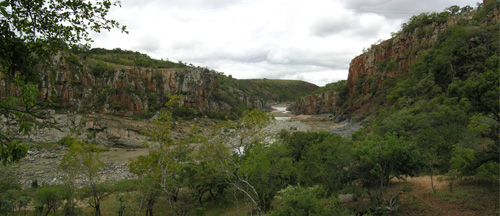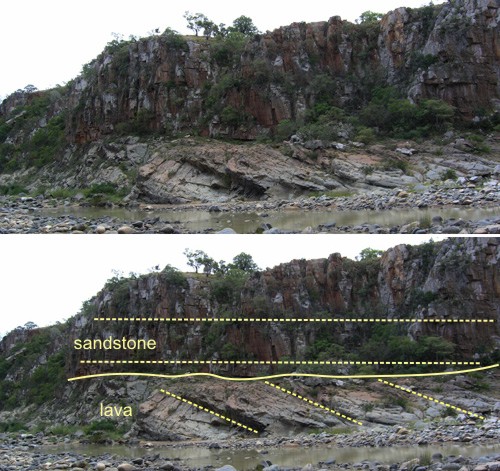The purpose of last week’s little jaunt into the field was to revisit the White Mfolozi River section that I first sampled last year. My target this time was the uppermost lava unit of the two in the section:

In the picture above, the lava unit, outcropping extensively in the river, is sandwiched between two sandstone formations. The lower sandstone is represented by the massive bed on the far bank of the river on the left; the upper sandstone can be seen in the sheer cliffs that the river runs towards. What’s nice about this section is that the river is flowing in roughly the same direction as the dip of the beds (away from the viewpoint of this photo), making it quite easy to sample at regular intervals.
(More photos below the fold)
To get to where we were staying, you just have to follow the river around the corner, where the river has cut a sheer canyon through the upper sandstone. This is the view from the hut we were staying in, which seems to have been built to accommodate rock climbers. From the guides and information in the hut, it’s quite a popular destination, although we didn’t see anybody.

The lavas are still outcropping in the lower banks until about half-way up the picture. If you look on the left, you can see that the contact with the sandstones is an angular unconformity: the lava flows are dipping a bit more steeply, and in a different direction, than the overlying quartzite beds, meaning that the lavas were uplifted and folded (and probably eroded) before the younger sandstones were deposited. This sequence isn’t yet dated well enough to know exactly how much time is missing at this contact – it could be tens of millions of years, although when you’re looking at rocks that are somewhere between 2900 and 3000 million years old, it’s a little too easy to dismiss such an interval as insignificant. Such are the perils of overdosing on Deep Time.

Just in case you start thinking that this is all looking a bit cushy and idyllic, we had to walk past this sign on the way down to the river:

Plus, there’s the fact that I was drilling cores from early morning until evening:

These are actually the first pictures that have ever been taken of me drilling, because for most of my palaeomagical career thus far all of my field work has been a solo effort. This time, however, a Masters student was volunteered for the dubious honour of assisting me, and it is he who is responsible for the even more dubious bonus photos of me in action. Thanks to his assistance, I also managed to sample pretty much the entire section on this single trip. Not bad.



Comments (1)